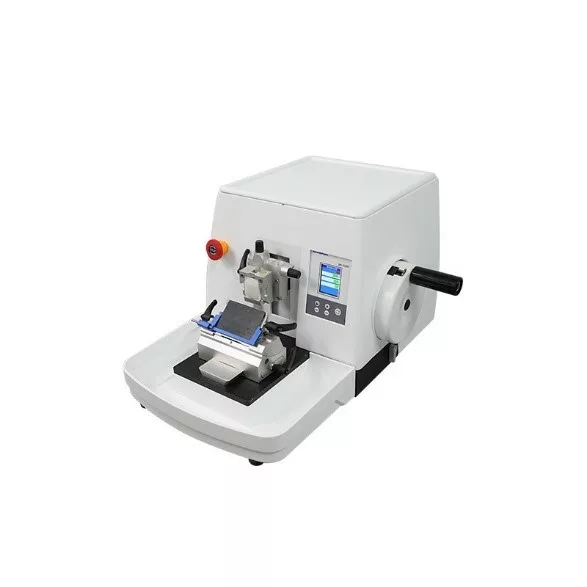Automatic Microtome: Precision Sectioning for High-Quality Histological Samples
In the fields of pathology, histology, and research laboratories, the Automatic Microtome KAM/A/72 is an indispensable tool. This high-precision instrument is designed to section biological samples, such as tissue, into extremely thin slices for microscopic analysis. Whether in medical diagnostics or advanced research, an automatic microtome ensures accuracy, speed, and reproducibility in sample preparation. It plays a crucial role in producing high-quality slides essential for detailed examination.
What is an Automatic Microtome?
An Automatic Microtome is an advanced slicing device used to prepare very thin sections of material, typically biological tissues, for examination under a microscope. It automates the cutting process, ensuring uniform slices with precision that manual microtomes cannot achieve. The device uses a sharp, high-grade blade to create sections, with users able to set desired slice thickness, usually ranging from 0.5 to 100 micrometers.
Automatic microtomes are commonly used in:
- Pathology Labs: For preparing tissue samples for disease diagnosis.
- Research Laboratories: For preparing specimens for research purposes.
- Pharmaceutical Development: In testing and analyzing drug effects on tissue samples.
- Educational Institutions: For training and research purposes.
How Does an Automatic Microtome Work?
An Automatic Microtome streamlines the sectioning process, offering a fully automated cutting system. The sample, often embedded in paraffin wax, is placed in a sample holder, which moves vertically against a fixed, extremely sharp blade. The microtome adjusts the thickness of each cut to meet the specifications required for the analysis.
The automation allows for precise control over speed, thickness, and angle, ensuring consistent results with minimal manual intervention. Advanced microtomes come with digital displays and controls, enabling technicians to fine-tune parameters and improve the efficiency of the workflow.
Key Features of a High-Quality Automatic Microtome
When choosing an Automatic Microtome, here are the features to look for:
- Precision Control: Offers fine adjustments in section thickness to produce thin, uniform slices for high-quality microscopy slides.
- User-Friendly Interface: Intuitive controls, digital displays, and programmable settings make operation easy for lab technicians.
- Durability: High-quality materials, including corrosion-resistant metals and precision-engineered blades, ensure the device lasts even with regular use.
- Motorized Operations: Automation of the slicing process improves efficiency and reduces human error, allowing for high throughput in busy labs.
- Safety Features: Built-in safety mechanisms, such as automatic blade covers and emergency stop functions, ensure operator safety.
- Ergonomic Design: Reduces strain during operation and allows for continuous use in high-demand environments.
Applications of Automatic Microtomes
Automatic Microtomes are widely used across several industries and research fields, including:
- Medical Diagnostics: Preparing tissue samples for identifying diseases, including cancer, infections, and other pathological conditions.
- Histopathology: Preparing tissue slides for detailed study under a microscope, assisting in disease diagnosis and research.
- Biomedical Research: Examining the effects of drugs, pathogens, and genetic modifications on tissue samples.
- Forensic Science: Analyzing tissue samples as part of forensic investigations.
- Pharmaceutical Testing: Assessing the impact of pharmaceutical compounds on tissue samples, helping in drug development.
Benefits of Using an Automatic Microtome
- High Throughput: Automation allows for faster sample preparation, increasing the number of slides that can be produced in a given time.
- Unmatched Precision: Achieves uniformity and reproducibility in sample thickness, essential for accurate and reliable analysis.
- Reduced Human Error: Automation reduces the possibility of inconsistencies in manual slicing, ensuring high-quality slides every time.
- Increased Safety: With automatic features and safety mechanisms, the risk of accidents or injuries is significantly reduced.
- Time-Saving: Technicians can focus on analysis rather than manual slicing, improving workflow efficiency and productivity.
- Enhanced Quality of Research and Diagnostics: Thin, accurate slices provide clearer, more detailed microscopic images, leading to better diagnostics and research outcomes.
Choosing the Right Automatic Microtome for Your Lab
When selecting an Automatic Microtome, it’s crucial to consider the specific needs of your lab or research facility. Factors such as the types of specimens you work with, the desired section thickness, the frequency of use, and budget are all important considerations. Investing in a high-quality automatic microtome can enhance the efficiency of your lab and improve the quality of your histological preparations.
Conclusion
An Automatic Microtome is an essential tool for laboratories focused on precise and efficient sample preparation. Its automated technology ensures consistent, high-quality results, whether for routine diagnostics or advanced research. As laboratory demands grow, choosing the right microtome can significantly impact productivity, safety, and the accuracy of your findings.





Reviews
There are no reviews yet.